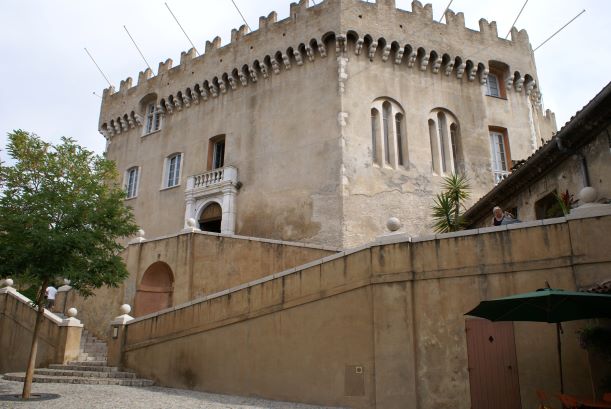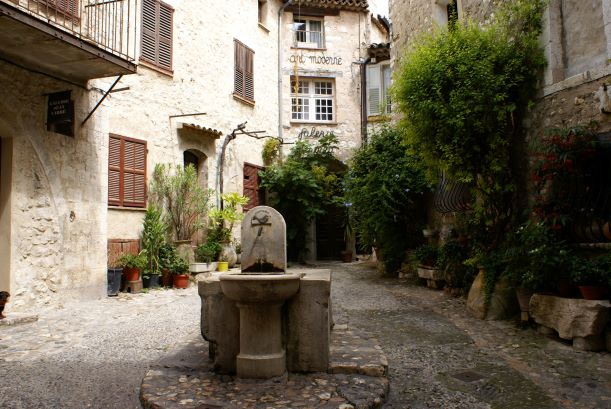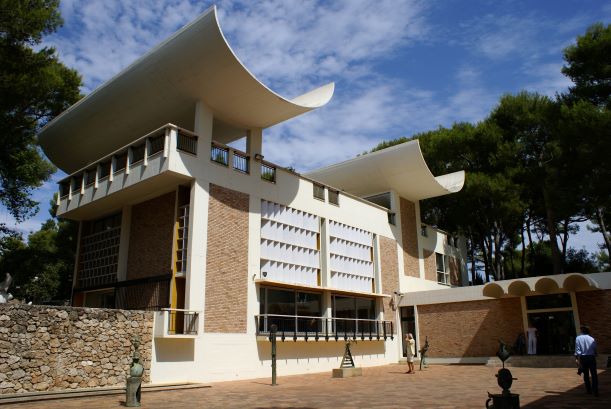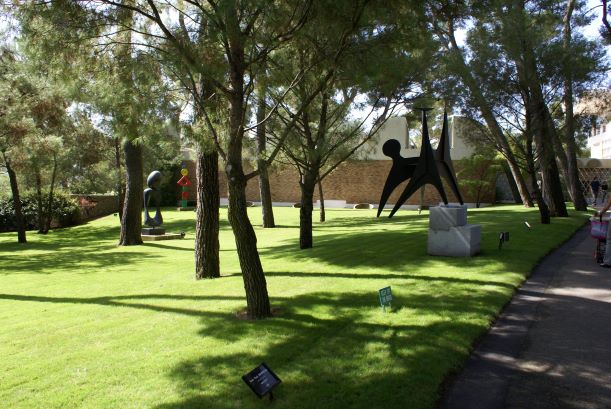It can be easy to forget in these well connected days that southern France was little visited prior to the days of the railway. Although crossed by trade routes which functioned from the time of the ancient Greeks, few people would make the effort to travel unless driven by mercantile greed when much of the goods and people passed through trans alpine routes well inland. Smollett, the eighteenth century Scottish doctor, and not the modern American celeb, made the effort and his Travels through France and Italy (1766) gives a good idea of how hard it was to get to the South coast by land and what life was like once one got there. For example, the now popular summer resort of the Gorges de Verdon, France's version of the Grand Canyon now about 3 hours drive from Nice, were only known to Paris when Louis XVI's cartographers reached there in the 1780's, and then only because a local farmer showed it to them.
What society existed inland and away from the navigable rivers was often perched defensively on hill tops, hence the description of these retreats as Village Perchées. Here the residents could retreat within curtain walls provided by their housing to protect themselves from the advances of North African raiders keen to meet their slave quota and grab any readily movable wealth. Nice still rowed out to combat with prisoner-powered galleys in the days of Smollett, and the North African raiders were not completely brought under control until a resurgent French military took control of Algiers in the 1830's.
Hence the fortifications of larger places, such as Antibes were not atypical. The Grimaldi castle of Antibes is repeated in Monaco, St Paul de Vence, and Cagnes (below, see Cagnes, the latter worth a visit to get a feel for how self sufficient these remote settlements had to make themselves. The castle also contains a good museum for the local olive industry although not explaining why, when so much is made locally, the green fluid costs so much in the local shops relative to those of Italy which are so near. The Cagnes castle can be visited by public transport by catching a train from Antibes station to that of Cagnes Sur Mer. There is a bus station at Cagnes Sur Mer station where a sTrain from Antibes to Biot station where you can take the 09 bus or walk to Square Bourdet where there is a shuttle bus up to the the castle, or enjoy the steep walk.

The south east of France has been a prime drawcard for both the French and foreigners for a century and a half. Initially the winter climate was sufficient to draw Northern Europeans from their smog filled, dank, industrial cities and Queen Victoria was an early adopter who took advantage of the trains service established between Paris and Nice. From the 1920s, the summer beaches began to draw people to the warm sea and relaxed lifestyle. Coco Chanel (Chanel's Riviera by Anne de Courcy) blessed the suntan following a cruise on her then boyfriend's, the Duke of Westminster's, yacht ("yacht" is a word used in the south of France for anything from some bit of fibreglass which can accommodate two up to small ocean liners). More generally along the coast from Marseilles to Nice, the nineteenth century artists began to discover the clear light, so different to that which they experienced along the Northern European coast near to their Paris orientated customers. Unsurprisingly, any description of the area around Antibes becomes peppered with references to artists.
For a more fullsome read about early twentieth century French based artists by someone who was there, knew them, and bought the works, I'd recommend Peggy Guggenheim's Out Of This Century, Confessions Of An Art Addict which provides insight not only into the artists' lives but also the gilded rich who supported them, and into the horror which was the Nazi invasion.
A Note on Travelling Around Antibes
The local rail service travels along the coast to beyond the Italian border in the East, and to Frejus in the west but then turns inland towards Marseille. This serves well for visiting Cannes, Juan Les Pins, Antibes, Biot, Cagnes, Nice, Villefranche, Monaco, and Menton. Marseille can be reached directly by train although perhaps for an overnight stay. A car is the best for travelling inland although buses will get you to many places but slowly and not often.
Many visitors to the Côte d'Azur want to get to St Tropez but this requires either a car, and a lot of patience in summer, or the boat service from Juan Les Pins which runs in summer: best to use the internet to search for current times and cost. The road, the D559 from Frejus along the coast or the D25 down from the A8, can be very busy in summer: we gave up at Sainte-Maxime the last time we tried it.
In no particular order, these are some of the local sights we recommend and know.
Vence and St Paul de Vence
St Paul is a Village Perchée located to the North East of Antibes. About a one hour drive from Antibes. The alternative is to catch the train to Cagnes-Sur-mer station and then the 655 bus up to the village. Worth a visit in itself and just south of Vence which is known as the site of Matisse's Chapelle de Rosaire. See Saint-Paul de Vence
St Paul de Vance meets everyone's expectations of the Côte d'Azur: medieval fortifications; artist colony; top class restaurant in the Colombe d'Or where artists really did settle their bills with paintings some of which continue to hang in the restaurant; cafes and bars and cheaper restaurants; boules being played at the village entrance; and views across to the azure sea. BUT you would need to book weeks in advance for the Colombe d'Or and prices to eat and stay in the village generally are high. It has the advantage of an underground car park which in our experience usually has spaces available. The village has hotels although we find a day trip sufficient: it is a small place.
A note on French car parks: they tend to be tight fitting.

Fondation Maeght
The Fondation is about twenty minutes walk from the village. It is a modern art collection based around the collection of art dealers Marguerite and Aimé Maeght. It includes works by many of the artists of the first half of the nineteenth century including Joan Miró, Marc Chagall, Alberto Giacometti, Georges Braque, Alexander Calder and Fernand. Built in the 1960's, the building is a fine example of the modern French concrete style.

The delight of the local climate is that many of the artworks can be displayed outside.

Nice
Nice is a big enough city to be whatever you want. The old city sits to the east of the long built over lower reaches of the river Paillon. A city more recognisable as nineteenth century sits to the west and was built in a style similar to Turin from which it was governed prior to the 1860s. The old city climbs up Mont Boron with the Port at its sea base to the other side from the city. Gardens sit on the peak of this page hill and can be reached by an elevator on the east side. The old port can also be reached by walking around the sea side of the hill. The port has ferry services to Corsica.
The new city stretches back from the beach into the foothills. Originally it stood back from the sea. This was in the days when people wanted to keep out of the water and were disinclined to undress in public. The Scottish Dr Smollet raised interest when he entered it in 1866 and drew a small crowd for his morning health dip. Nowadays the pebble beach rises to a two carriageway road beyond which sit rows of apartment blocks and hotels. The road is named the Promenade des Anglais and its pedestrian pavement is somewhere to stroll, rollerblade, and be seen. The road is so named because the local English church's vicar got his congregation to fund its construction to provide paid work for the poor after a harsh winter in 1820. The old city is a larger version of Antibes. Be prepared for steep roads, and tourist crowds.
Beyond the retail, food, drinking, and entertainment, Nice offers art galleries which reflect the late nineteenth and early twentieth century art movements. In no particular order we recommend:
Musée Matisse Nice: Matisse visited and subsequently lived in Nice form the First World War until his death in 1954. Feted as the artist who along with Picasso carried French modern art forward from the Impressionist style. Matisse Museum
Musée National Marc Chagall: Chagall was one a substantial group of Russian Empire Jewish artists who moved to France before and after the Russian revolution. Nowadays this group is beginning to be regarded as a school of art of its own. Marc Chagall Museum
Villa Massena: art gallery and museum of Nice housed in a former winter palace of one of the French post revolution aristocracy. It houses collections of art illustrating, and artefacts of Nice's heritage. Villa Massena